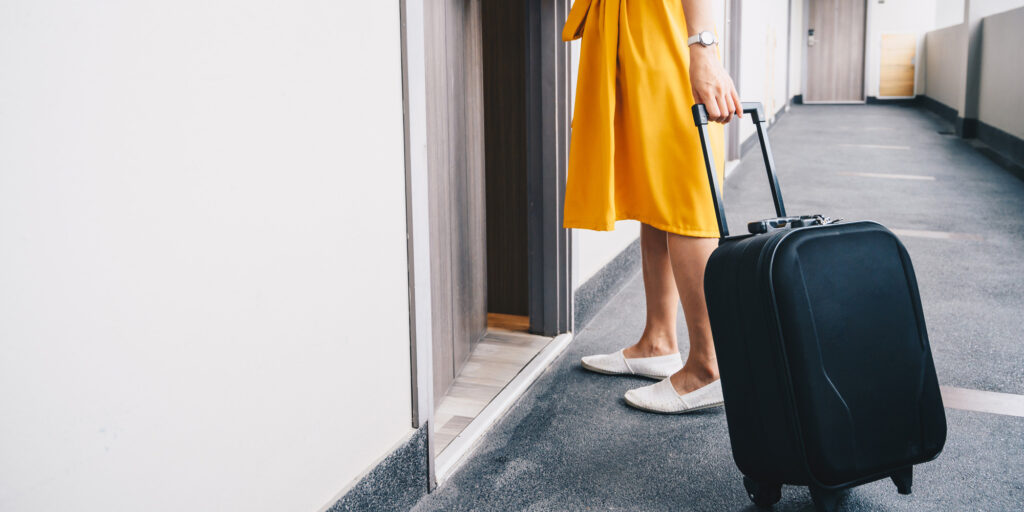
How to Reopen Your Hotel Post COVID-19
A Guideline for Hotels to Welcome Guests Again
Using Proper Social Distancing Measures
By Sam Evers, Chief Strategy Officer at ALICE
Over the next few months, we believe hotels will begin to reopen. With COVID-19 still looming, the question on everyone’s minds is how hotels will do so in a way that is safer than before and builds trust with guests. At ALICE, we have researched how other regions, independent operators, and industries are approaching the rebound.
We’ve published a set of broad guidelines for all hotels to leverage in hopes you will find it useful as a guide to what we all believe will be a road to recovery.
A lot has been written over the past two months on the devastation wreaked upon our industry by the COVID-19 pandemic. We’ve seen closures, historically low occupancy levels, and wave after wave of layoffs, furloughs, and a lot of speculation about when the contraction of the industry will end.
More recently, the conversation has started to shift towards predicting when hotels might start welcoming guests back through their doors.
Some parts of Asia are starting to do so already, and are providing a handful of data points we can learn from in our efforts to predict what the path may be for the rest of the world. The reality is that the answer is going to look different in every country, and in some cases on an even more localized basis. Globally, we are seeing non-uniform approaches taken to “flatten the curve” of coronavirus cases, with varying degrees of success, and wildly varying testing capabilities.
We are not public health experts here at ALICE, so we don’t have much to add to these predictions to advance the conversation. However, what we do know from our recent surveys is that our customers are starting to plan their reopening as they hope to be able to have their team members return to work in the next 3 months. Regardless of timelines, we have an unwavering faith that the industry WILL rebound.
The conversation we want to have is not about when, it is about how.
Reopening a hotel involves three distinct areas of focus: the property, the staff, and the guests. So far we have been focused specifically on the property itself. In a previous post, Dmitry Koltunov, the CTO of ALICE, wrote about the different phases that a hotel will go through from shutting down or operating with no occupancy all the way back to reopening and operating at low or full occupancy.
We have created detailed checklists focused on how to secure the property and assets during these phases.
Most hotels are not familiar with temporarily shutting down, or even operating with a skeleton crew, except for seasonal properties that have been doing this for years…so we looked to them for guidance. When we look past the physical assets, however, we start to enter uncharted territory. Hotels are not just reopening their doors after a seasonal change.
They are reopening their doors in an unfamiliar post-COVID environment where stakeholder expectations are fundamentally different than they were just a few months ago.
To answer the question of how hotels will successfully reopen, we have to start by understanding the needs and safety of two separate stakeholders; guests and staff. You can tell the whole world that your doors are open and you’re ready to welcome guests back, but what measures will it take to build trust and confidence for them to come knocking?
The answer to reopening with restored consumer confidence lies firmly in the realm of safety and cleanliness. We need to instill a new-found sense of confidence in travelers that our hotels are a safe haven for them in a new normal where person-to-person contact and surface contamination are as scary as physical security and privacy concerns.
This means rethinking our standard operating procedures (SOPs) for everything from hotel room sanitization, to check-in, to the layouts of public spaces.
It also means making sure guests know about it. Some hotels are already starting to do this. Marriott recently announced a Global Cleanliness Council to address these types of concerns within their portfolio. The government of Singapore has instituted a national certification process called SG Clean. While both are really helpful, they are too specific to be used by the majority of hotels. So, we created a more generalized guideline that is built to help the rest of our industry.
In the Post COVID-19 Hotel Reopening Guidelines, you will find recommendations to help hotels think about how to reopen to guests, including how to properly clean guest rooms, perform health screenings, maintain common guest areas, and much more. We are a US-based company, so we have chosen to reference US government entities when referring to any regulatory bodies. But we believe that the spirit of each guideline is universally applicable regardless of your region.
These are not specific SOPs, but rather a framework hotels can use to develop a deeper set of procedures based on the guidance. What we plan on releasing next is a step-by-step solution around how to flesh out a deeper set of SOPs, and how technology can be used to enhance and monitor their execution.
The saying “this too shall pass” has never been more applicable. The way you handle reopening your hotel (and the way you communicate your new procedures to guests) could mean the difference between your property getting booked over the one across the street. And while we can’t predict the future, it’s becoming obvious that the assurance of cleanliness and safety will be prioritized over luxury.
Post COVID-19 Hotel Reopening Guidelines
Below you will find a list of COVID-19 hotel guidelines that we hope you will find helpful when thinking about how to reopen your hotel and safely welcome back guests in a way that inspires consumer confidence. You’ve probably already thought about some, or even many of these topics; but maybe not all of them. We have all been put on a steep learning curve over the past few months, and we will update this document as we continue to learn more about how the landscape is evolving.
*These guidelines are not meant to supersede or replace any existing government or local agency regulations. As the regulatory environment changes, it is important to stay abreast of updates and ensure that you remain in compliance.
Preparing to Reopen
- A single employee at the hotel should be appointed as the Safety and Cleanliness Officer (SCO) responsible for oversight and compliance with all of the guidelines listed in this document. If none is appointed, the responsibility will default to the general manager of the hotel.
- Disinfect all guest rooms, common areas, back of house facilities, offices, gym, spa, restaurant, etc…using EPA, CDC, and OSHA approved materials and guidelines.
- Document all COVID-19 preparedness and response procedures as outlined in this document.
- Provide training to all staff members prior to reopening on new COVID-19 procedures.
- Consider keeping certain public amenities closed such as pools, gyms, and spas
Health Screening
- Close all entrances, except the main entrance for the public and guests, and one entrance for staff, where a health screening can be set up and implemented.
- All guests, staff members and 3rd party contractors who feel ill, have been asked by a medical professional or government official to self-quarantine, or exhibit any of the World Health Organization (WHO) identified COVID-19 symptoms such as an elevated temperature, dry cough, shortness of breath, loss of smell or taste, etc…should not be allowed on premises and must get tested for COVID-19 prior to returning to the property. A log of these temperature and symptom screenings must be kept on record and made available to government or medical professionals if required.
Receiving Guests
- Front desk and concierge areas must enforce appropriate social distancing between guests while they wait in line to check-in and have a process for ensuring the line moves as quickly as possible and does not obstruct the flow of foot traffic through the lobby and entrance.
- Ensure that check-in and check-out lines are segregated from each other, and segregated from foot traffic, to ensure appropriate social distancing at all times.
- Where feasible, contactless check-in procedures should be implemented, such as mobile check-in, e-signature options, and self-swipe credit card payments.
- Disinfectant supplies must be made available at the front desk and concierge and used to sanitize any materials, such as pens used for signature that the previous guests have been in contact with.
- Placement of disinfectant supplies and procedures for their use must be in plain view of the guest through either physical materials or digital signage.
- Guest procedures around social distancing, face-to-face interactions, and any other COVID-19 related items must be displayed at the front desk and concierge using either physical materials or digital signage.
Large Events and Gatherings
- Large gatherings should be restricted in all common areas and event spaces where appropriate social distancing cannot be maintained.
- Government regulations limiting gathering sizes are, and will continue to be, applied in different ways by region and municipality. The SCO must ensure that all federal and local regulations concerning the ongoing safety of conferences, conventions, private events, and large group bookings are followed as updates occur.
Common Areas
- Ensure that all seating arrangements in lobbies allow for appropriate social distancing between different parties. Guests traveling in the same party may stay closer together if they choose, but should have the option not to.
- Remove any shared amenities from the lobby such as water and food stations.
- Develop a cleaning schedule to ensure an increased frequency in cleanings for all common areas including (but not limited to) lobbies, bathrooms, stairs, and hallways.
- A record of the cleaning schedule and its completion must be kept and displayed in a public area where guests can easily see it using either physical or digital signage.
- Hand sanitizer stations should be accessible to all staff and guests in each common area, next to any ATM, and at least one location per floor of guest rooms, preferably every elevator bank.
- Signage should be put up at all elevator entrances restricting elevators to a maximum capacity that ensures appropriate social distancing given the size of the elevator.
- Develop a protocol for ensuring guests and staff can maintain appropriate social distancing when they encounter each other in all public areas including stairs and hallways.
Guest Rooms
- Staff must ensure that they have all required materials prior to entering a guest room so that all necessary actions can be completed in one visit to limit cross contamination.
- All guest rooms, upon check-out, should be disinfected using EPA, CDC, and OSHA approved materials and guidelines.
- A room cleaning schedule while guests are in-house should be developed that minimizes interactions between staff and guests, and offers guests the ability to opt-out of room cleanings during their stay.
- Staff should display signage that they are currently in the room when cleaning or maintaining a room so that guests can avoid entering during this time in order to limit staff and guest contact.
- Develop policies for the proper usage and changing of personal protective equipment by any staff member entering a guest room.
- Guests must be notified that their rooms have been cleaned following EPA, CDC, and OSHA approved materials and guidelines upon completion of room inspection using either physical materials placed in the room or through digital communication.
Amenities
- Seating at restaurants and bars must be arranged to allow for appropriate social distancing between tables, and individual seats at bars where appropriate.
- Restaurant table and seat surfaces must be cleaned immediately following the departure of any guests.
- Where applicable, amenities including (but not limited to) pool chairs and workout equipment must be arranged to allow for appropriate social distancing between guests. Guests traveling in the same party may stay closer together if they choose, but should have the option not to.
- A cleaning schedule should be developed to ensure an increased frequency in cleanings for all locker rooms and shared showers.
Infection Response
- Develop a process for handling any staff, guests, or 3rd party contractors who exhibit elevated temperatures or any WHO identified symptoms consistent with COVID-19.
- Suspected cases of COVID-19 must be taken to a quarantine area within the property via a pre-designated isolation route. Quarantine areas must be identified in advance for both staff and guests.
- Transportation must be arranged to a local medical facility where COVID-19 testing and treatment can be performed.
- An evacuation procedure must be in place for all remaining staff, guests, and 3rd party contractors that takes into account appropriate social distancing measures during egress and at the congregation side outside of the property.
- A cleaning and disinfection procedure must be in place for any areas on the property exposed to a suspected COVID-19 case including, but not limited to, the pre-designated quarantine area and isolation route, any guest rooms, common areas, amenities, or back of house locations.
- This procedure must also include criteria for when staff and guests may reenter the property, as well as how they will be notified of the successful operation and the steps taken to get there.







